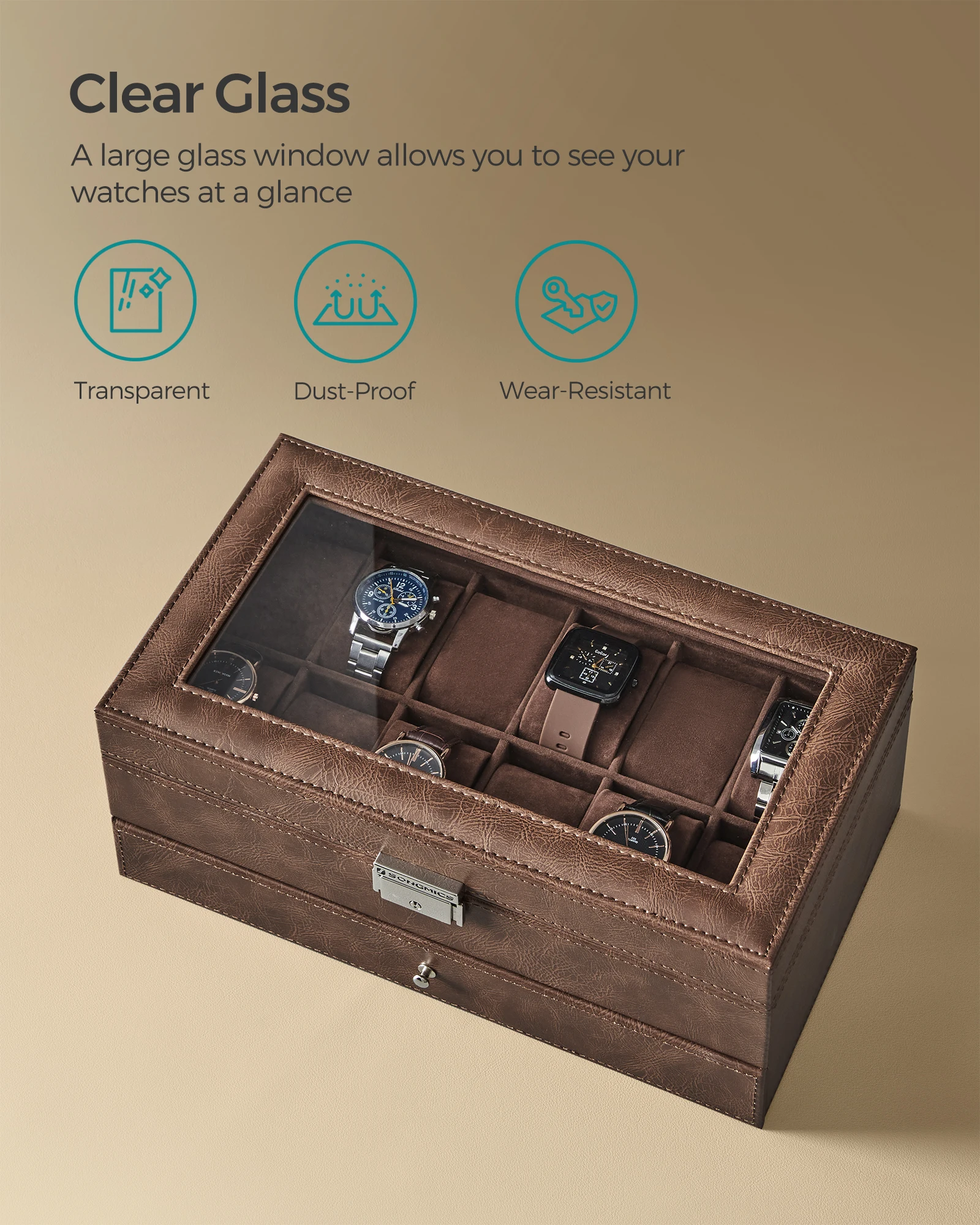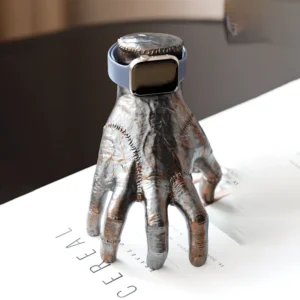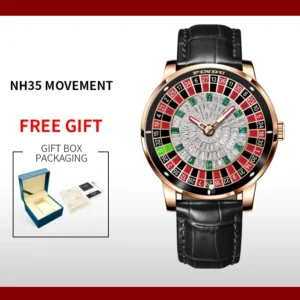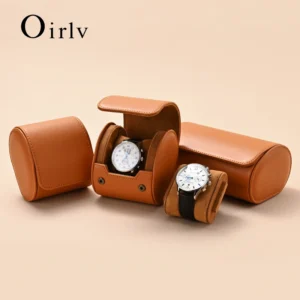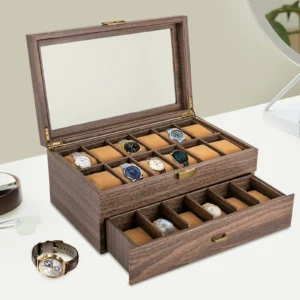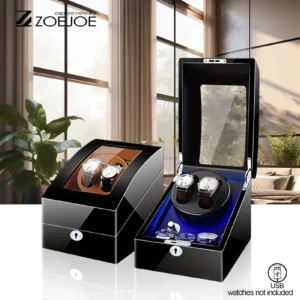The Essential Role of Quality Watch Boxes in Timepiece Preservation
When it comes to protecting valuable timepieces, a quality watch box is much more than just a storage container. The right watch box serves as both a protective vault and an elegant display for your prized possessions. Many watch enthusiasts invest thousands in their collections but overlook the importance of proper storage, which can lead to unnecessary wear and damage.
A well-constructed watch box provides crucial protection against environmental threats that can harm your watches:
- Shields delicate movements and finishes from dust particles
- Prevents exposure to humidity that can cause corrosion
- Reduces UV light exposure that can fade dials and damage straps
- Minimizes physical impacts and scratches when watches are not being worn
Most luxury watch brands specifically recommend proper storage solutions to maintain timepiece longevity. Studies show that watches consistently stored in quality boxes retain their appearance and function significantly longer than those stored casually. Additionally, proper storage directly impacts resale value—collectors and dealers alike place premium values on well-preserved timepieces.
Beyond protection, quality watch boxes provide organizational benefits that enhance your enjoyment of the collection. Finding the perfect system for organizing your watch collection helps you appreciate each piece while keeping them secure.
In this comprehensive guide, we’ll explore the materials, construction techniques, and design elements that separate exceptional watch boxes from basic storage options. You’ll learn how to evaluate quality, select the right box for your collection, and maintain your storage solution for years of reliable protection.
Understanding Watch Box Materials: Impact on Protection and Aesthetics
The materials used in watch box construction play a dual role in both protecting your timepieces and enhancing their presentation. Different materials offer varying levels of protection, durability, and visual appeal, making material selection one of the most important factors when choosing a storage solution.
When evaluating watch box materials, consider how they balance these key aspects:
- Protective qualities: How well the material shields watches from environmental factors
- Durability: How the material withstands daily use and the passage of time
- Aesthetic appeal: How the material complements and showcases your collection
- Value relationship: How the material quality aligns with your watch collection value
Experts generally recommend matching your storage quality to your collection value—premium watches deserve premium protection. However, this doesn’t necessarily mean the most expensive option is always best. The ideal material depends on your specific watch storage needs as a collector and the conditions where you’ll keep the box.
Material choices impact not just the protection level but also the weight, maintenance requirements, and longevity of the watch box itself. For example, solid hardwood boxes offer exceptional durability and classic aesthetics but may require occasional conditioning, while aluminum cases provide lightweight protection ideal for travel but might not offer the same visual warmth.
The right balance between protective qualities and visual appeal depends on whether you prioritize display or secure storage. Some collectors prefer glass-topped display cases that showcase their collections, while others prioritize solid boxes that offer maximum protection from light exposure.
Premium Wood Options: Traditional Elegance Meets Superior Protection
Wood remains the classic choice for watch boxes, combining timeless elegance with excellent protective properties. Different hardwoods offer varying characteristics, each with unique benefits for watch storage:
Mahogany
– Rich, reddish-brown coloration that deepens beautifully with age
– Excellent stability and resistance to warping
– Dense grain pattern that takes finish exceptionally well
– Traditional choice for heirloom-quality watch boxes
Walnut
– Distinctive dark chocolate tones with occasional purple undertones
– Natural oils provide some resistance to moisture
– Strong durability with less likelihood of splitting
– Elegant grain patterns that create visual interest
Oak
– Exceptional strength and durability
– Prominent grain texture adds visual character
– Excellent resistance to daily wear
– Available in red or white varieties with different tonal qualities
Cherry
– Warm reddish tone that develops a rich patina over time
– Smooth, straight grain pattern
– Moderate hardness balances durability with workability
– Natural luster that enhances finish quality
High-quality wooden watch boxes utilize traditional joinery techniques that enhance both durability and appearance. Look for these construction methods that indicate superior craftsmanship:
- Dovetail joints at corners for maximum structural integrity
- Finger joints that create strong, attractive connections
- Splined miter joints that reinforce vulnerable corner areas
- Mortise and tenon construction for rigid, long-lasting assembly
The finish applied to wooden watch boxes serves both protective and aesthetic purposes. Quality options include:
– Hand-rubbed oil finishes that highlight natural wood grain
– Multiple layers of lacquer for durability and moisture resistance
– French polish for exceptional clarity and depth
– UV-resistant clear coats that prevent fading and discoloration
When considering wood and leather watch boxes, remember that wood requires proper environmental conditions—extreme humidity changes can affect wood over time, so consistent indoor conditions are ideal for maintaining wooden watch boxes.
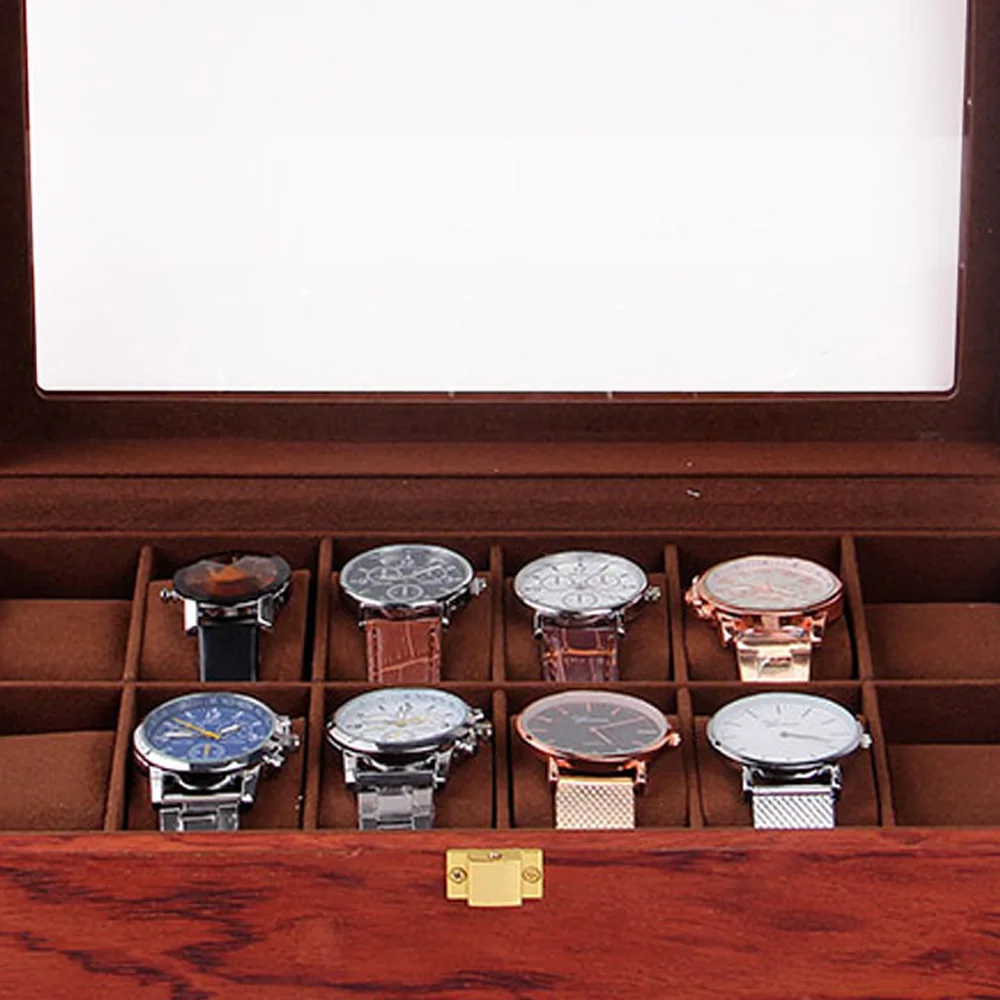
Leather Watch Boxes: Luxurious Appeal and Practical Benefits
Leather watch boxes combine sophisticated aesthetics with practical protective features, making them popular choices for discerning collectors. The quality of a leather watch box largely depends on the grade of leather used:
Full-Grain Leather
– Highest quality with natural surface intact, including visible grain and markings
– Develops a beautiful patina over time that enhances character
– Extremely durable with excellent resistance to moisture
– Offers superior protection while aging gracefully
Top-Grain Leather
– Slightly processed surface with some imperfections removed
– More uniform appearance than full-grain
– Good durability with less thickness than full-grain
– Balance of refinement and character
Genuine Leather
– Lower layers of the hide with applied texture
– Less durable than full or top-grain options
– More affordable while still offering leather’s basic benefits
– Typically requires more care to maintain appearance
For those preferring animal-free options, high-quality synthetic leathers provide alternatives with their own advantages:
– Consistent texture and appearance
– Excellent resistance to moisture and staining
– Lower maintenance requirements
– Increasing quality with modern manufacturing techniques
Leather watch boxes often feature contrasting materials and construction methods. Common combinations include leather-wrapped wooden frames for structural integrity with soft leather interiors for watch protection. The aging characteristics vary significantly between leather types—full-grain develops a rich patina over years of use, while some synthetic options maintain a more consistent appearance.
Proper care extends the life of leather watch boxes considerably. Light regular conditioning prevents drying and cracking, while keeping leather boxes away from direct sunlight prevents fading and deterioration of the material.
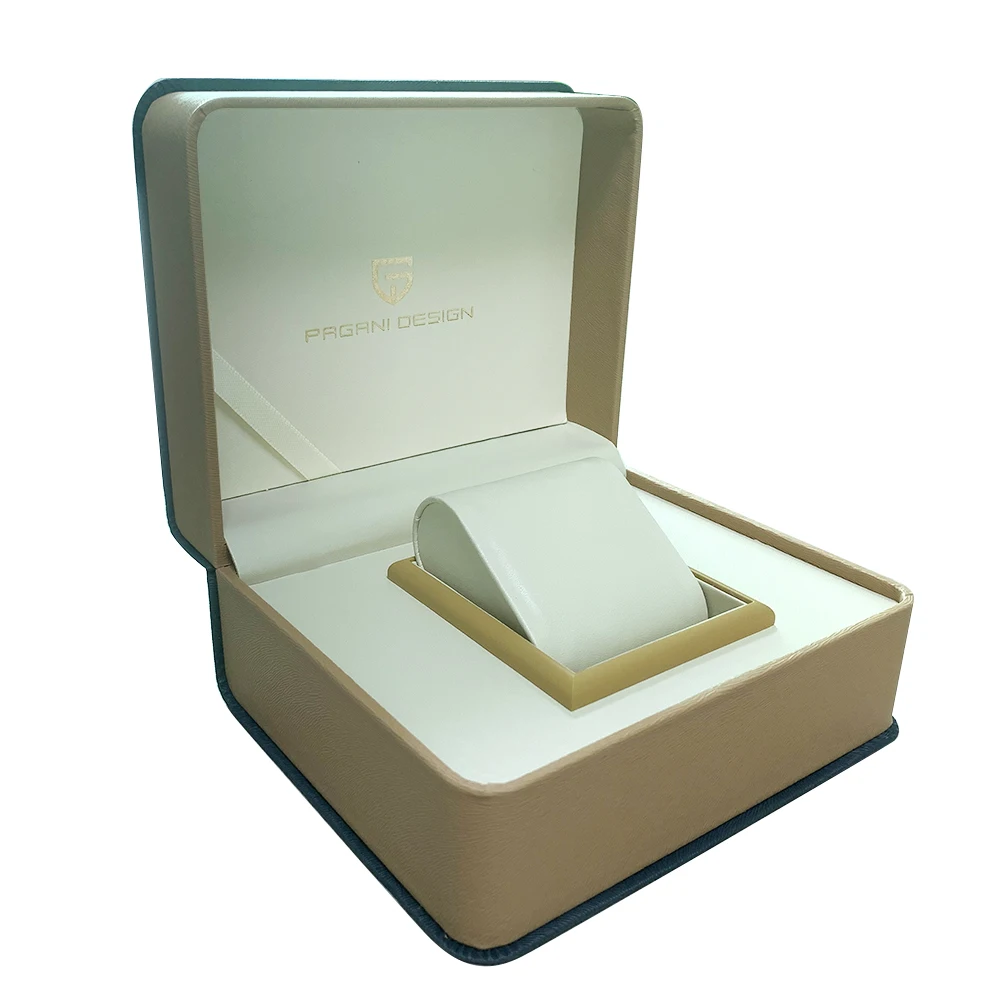
Modern Materials: Metal, Carbon Fiber, and Synthetic Options
Contemporary watch boxes increasingly incorporate modern materials that offer distinct advantages in protection, weight, and durability. These innovative options provide alternatives to traditional wood and leather while often delivering enhanced performance characteristics.
Aluminum
– Exceptionally lightweight yet surprisingly strong
– Excellent resistance to moisture and humidity fluctuations
– Modern, sleek aesthetic that complements contemporary watches
– Often used in high-end travel cases for its weight-to-strength ratio
Carbon Fiber
– Incredibly strong with minimal weight
– Distinctive woven pattern adds visual interest
– Superior impact resistance for maximum protection
– Premium material that matches advanced watch technologies
Stainless Steel
– Unmatched durability and resistance to damage
– Clean, industrial aesthetic
– Excellent security features possible with metal construction
– Virtually impervious to environmental factors
Acrylic and High-Grade Plastics
– Clear display options with excellent visibility
– Lightweight and resistant to impacts
– Modern manufacturing allows for creative designs
– Often used for display lids and protective inner components
When comparing types of watch storage, modern materials often outperform traditional options in specific categories:
- Impact resistance: Carbon fiber and aluminum offer superior protection against drops and impacts
- Moisture resistance: Metal and synthetic cases provide nearly complete humidity barriers
- Security: Metal construction enables advanced locking mechanisms
- Weight efficiency: Modern materials deliver protection at a fraction of traditional material weight
Innovative composite materials continue to emerge, combining beneficial properties of multiple materials. These include carbon fiber reinforced polymers, aircraft-grade aluminum alloys, and specialized synthetic fabrics that offer exceptional protection while reducing weight.
Modern material watch boxes often feature contemporary design elements like minimalist aesthetics, integrated LED lighting, and modular components that allow customization to specific collection needs.
Interior Lining Materials: The Critical Barrier Between Watch and Case
The interior lining of a watch box represents the direct contact point with your timepieces, making material selection here particularly critical. The right interior materials prevent scratches, absorb minor impacts, and provide stable positioning for watches of various sizes and styles.
Velvet
– Soft, plush surface that prevents scratching
– Traditional luxurious appearance
– Available in various pile heights for different levels of cushioning
– Excellent for preventing watches from sliding within compartments
Suede
– Slightly napped surface provides gentle contact
– Natural material that allows some breathability
– Subtle texture adds visual interest
– Often used in premium watch boxes for its refined appearance
Microfiber
– Extremely fine synthetic fibers prevent scratching
– Superior dust capture capabilities
– Often treated with anti-static properties
– Excellent moisture-wicking abilities
Alcantara
– Premium synthetic material resembling suede
– Exceptional durability compared to natural materials
– Resistant to staining and fading
– Maintains appearance with minimal maintenance
The relationship between watch materials and appropriate linings is important to consider. Metal bracelets benefit from softer, deeper pile materials that prevent scratching, while leather straps require breathable linings that prevent moisture accumulation.
Quality watch boxes often feature specialized watch pillows designed to maintain strap/bracelet shape while securing the watch body. These pillows should:
– Provide firm yet gentle support
– Accommodate various watch sizes
– Maintain natural curvature of straps and bracelets
– Prevent compression damage to leather or exotic strap materials
Anti-tarnish treatments are increasingly common in premium watch box linings, particularly beneficial for watches with silver, brass, or bronze components. These treatments inhibit oxidation that can discolor metals over time.
The density and thickness of padding beneath the lining material significantly impacts protection levels. High-quality boxes feature multiple density layers—firmer bases for structural support topped with softer materials for gentle watch contact.
Watch Box Construction Elements: Building Quality from the Ground Up
Beyond materials, the construction techniques and structural elements determine a watch box’s durability, functionality, and protective capabilities. Quality construction elevates even basic materials, while poor construction can undermine even the finest woods or leathers.
Key structural components that indicate quality construction include:
Framework and Support
– Reinforced corner joints that resist twisting forces
– Internal bracing that prevents warping over time
– Consistent thickness in structural elements
– Solid base construction that supports the weight of watches
Precision Assembly
– Tight-fitting joints with minimal gaps
– Smooth transitions between different materials
– Uniform spacing between compartments
– Precise alignment of movable parts like lids and drawers
Finishing Details
– Consistent application of stains, oils, or varnishes
– Smooth sanding with no rough edges
– Properly secured linings without bubbling or separation
– Clean, even application of glues and adhesives
When comparing watch boxes to watch rolls, construction differences become particularly apparent. Rigid watch boxes require significantly more complex construction techniques but provide superior protection against crushing forces and impacts.
Quality indicators that separate premium construction from basic include:
– Hidden hardware that maintains clean exterior aesthetics
– Mitred corners with reinforcing splines for durability
– Double-walled construction for enhanced protection
– Hand-finished edges and surfaces
Warning signs of poor construction include visible gaps at joints, uneven spacing of compartments, loose or poorly secured hardware, and interior linings that show signs of separation or adhesive bleed-through. These issues not only affect appearance but can compromise the box’s protective capabilities.
Lid Design and Hinges: Critical Components for Protection and Access
The lid and hinge system represents one of the most crucial and frequently used elements of a watch box, making their design and construction particularly important for both protection and convenience.
Lid Designs and Their Functions
– Flat lids: Maximize storage efficiency and provide complete protection
– Domed lids: Allow for taller watches or additional clearance for cushions
– Display lids: Incorporate glass or acrylic panels to showcase the collection
– Lift-off lids: Provide full access without hinge constraints
Glass and Display Considerations
– Tempered glass: Offers improved impact resistance and safety
– UV-protective glass: Prevents dial and strap fading
– Double-glazed options: Provide additional insulation against temperature changes
– Anti-reflective coatings: Enhance visibility of displayed watches
Quality hinges are essential for proper lid function and longevity. Superior options include:
Hinge Types
– Quadrant hinges: Support the lid at any position without slamming
– Piano hinges: Distribute weight evenly across the entire box width
– Hidden hinges: Maintain clean aesthetics while providing sturdy support
– Soft-close mechanisms: Prevent accidental slamming that can disturb watches
The tension and stopping points of lid hinges significantly impact daily usability. Quality boxes feature:
– Appropriate resistance that prevents accidental closure
– Precise stopping points that hold the lid open at convenient angles
– Reinforced mounting points that resist pulling away from the wood or material
– Smooth operation without catching or binding
For collectors with limited space for watch storage, specialized lid designs like front-opening doors or sliding panels can maximize accessibility while minimizing the required clearance area.
Proper alignment between lid and base creates an effective seal that minimizes dust infiltration—a detail often overlooked in lower-quality watch boxes. This precise fitment requires expert craftsmanship and quality control during manufacturing.
Watch Cushions and Compartments: Design Elements That Protect Individual Timepieces

The individual compartments and cushions within a watch box provide direct support and protection for each timepiece. Their design significantly impacts how securely watches are held and how well they’re protected from movement and contact with other pieces.
Watch Cushion Designs
– Oval cushions: Traditional shape that accommodates most watch sizes
– Adjustable cushions: Feature compressible cores or removable elements to fit various strap sizes
– Spring-loaded cushions: Automatically adjust to different bracelet expansions
– Flat cushions: Designed for ultra-thin dress watches
Quality cushions should provide these essential functions:
– Maintain natural curvature of straps and bracelets
– Securely hold watches without excessive tension
– Prevent lateral movement within compartments
– Accommodate various watch sizes from 34mm to 50mm cases
The spacing between compartments is critical for preventing watches from contacting each other. Premium watch boxes feature:
– Sufficient buffer space between slots
– Reinforced dividers that maintain separation
– Precise sizing that prevents watches from shifting position
– Consistent compartment dimensions for organizational clarity
For unusual watch types, specialized watch display holders offer tailored solutions for oversized watches, irregularly shaped cases, or watches with unusual strap configurations.
Materials used in cushion construction significantly impact their protective qualities:
– Memory foam cores provide custom-fitting support
– Structured synthetic fills maintain shape over time
– Multiple density layers combine support with soft surfaces
– Breathable materials prevent moisture accumulation under leather straps
Removable cushions offer additional versatility, allowing the box to be reconfigured for different collections or to accommodate watches of varying sizes. This adaptability extends the useful life of the watch box as collections evolve.
Closure Mechanisms: Balancing Security and Accessibility
The closure system of a watch box serves dual purposes: securing the contents against accidental opening while providing convenient access when needed. Different closure types offer varying levels of security, convenience, and aesthetic appeal.
Common Closure Types
– Push-button latches: Combine security with one-handed operation
– Magnetic closures: Provide silent, smooth operation with moderate security
– Lock and key systems: Offer maximum security for valuable collections
– Pressure clasps: Create secure closure with clean exterior appearance
When evaluating closure quality, consider these factors:
– Alignment precision when closed
– Tension consistency that remains stable over time
– Material quality that resists wear from repeated use
– Sound quality when operating (avoiding cheap-feeling clicks or snaps)
Security requirements vary depending on where you store your watches within your home. Bedroom storage might prioritize quiet operation, while living room display might emphasize security features.
The integration of the closure mechanism with the overall design impacts both functionality and aesthetics. Quality watch boxes feature:
– Flush-mounted hardware that avoids protrusion
– Complementary metal finishes that match other box elements
– Reinforced mounting areas that prevent loosening over time
– Smooth operation without requiring excessive force
For travel applications, closure security becomes particularly important. Advanced options include:
– Multi-point locking systems that secure the lid at multiple locations
– Recessed locks that prevent accidental triggering or damage
– Combination locks that eliminate the need for keys
– TSA-approved security options for air travel
The most sophisticated watch boxes balance security with convenient access, ensuring that daily use remains practical while providing appropriate protection when the box is stored or transported.
Specialty Watch Boxes: Display Cases, Winders, and Travel Options
Beyond standard watch boxes, specialized storage solutions address specific collector needs with unique construction and design elements tailored to particular purposes.
Display Cases
Watch display cases feature enhanced visibility elements including:
– Larger glass panels with minimal framing
– LED lighting systems that highlight watch details
– Angled display platforms that showcase pieces at optimal viewing angles
– UV-protective glass that prevents dial fading during display
Watch Winders
Automatic watch winders incorporate mechanical components requiring specialized construction:
– Noise-dampening materials that ensure quiet operation
– Precision motors with multiple directional settings
– Programmable rotation cycles that match watch requirements
– Power management systems for efficient operation
Travel Cases
Watch travel cases emphasize protective elements:
– Impact-absorbing exterior materials that withstand handling
– Reinforced corners that resist crushing damage
– Water-resistant seals that prevent moisture intrusion
– Compact dimensions optimized for packing efficiency
Multi-Function Storage
Combination systems offer versatility through:
– Modular compartments that accommodate various accessories
– Drawer systems for organizing tools and spare parts
– Integrated jewelry sections for complementary storage
– Removable trays that allow customized organization
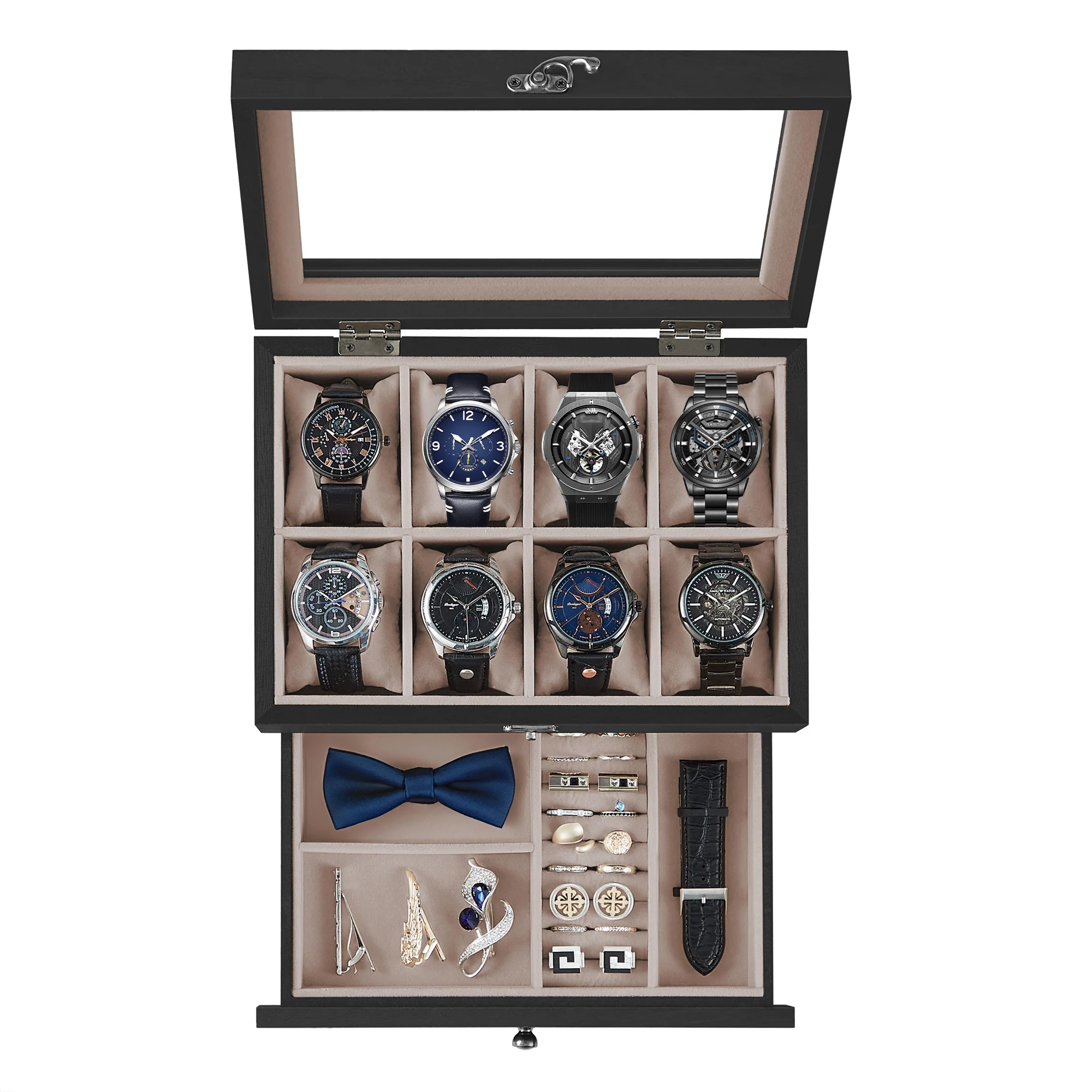
Each specialty type requires specific construction considerations. Watch winders need stable power supply integration and sound-dampening materials to operate quietly. Display cases require additional structural support for glass elements and proper light positioning. Travel cases prioritize lightweight yet durable materials with superior impact resistance.
Multi-functional watch and jewelry boxes represent a comprehensive storage solution, combining watch storage with space for rings, necklaces, and other accessories. These combination pieces require thoughtful interior design to properly protect different types of items with appropriate compartments and materials.
Size and weight considerations vary significantly across specialty types. Display cases tend to be larger to maximize visibility, winders require additional depth for motor components, and travel cases emphasize compactness and lightweight construction.
Watch Accessories, Watch Holder
$94.51 Select options This product has multiple variants. The options may be chosen on the product pageLuxury Watch Boxes, Men's Watch Boxes, Single Watch Box
Price range: $903.35 through $980.97 Select options This product has multiple variants. The options may be chosen on the product pageSingle Watch Travel Case, Watch and Jewelry Box, Watch Roll Travel Case
Price range: $93.44 through $140.65 Select options This product has multiple variants. The options may be chosen on the product pageMen's Watch Organizer, Watch Display Case, Watch Organizer
Price range: $112.68 through $169.45 Select options This product has multiple variants. The options may be chosen on the product pageAutomatic Watch Winder, Luxury Watch Winder, Single Watch Box
$307.39 Select options This product has multiple variants. The options may be chosen on the product pageLuxury Watch Boxes, Luxury Watch Travel Case
Price range: $200.33 through $224.57 Select options This product has multiple variants. The options may be chosen on the product page
How to Assess Watch Box Quality: Expert Evaluation Techniques
Evaluating watch box quality requires attention to specific details that indicate superior materials and construction. These practical assessment techniques help identify truly premium options from merely attractive but less functional alternatives.
Visual Inspection Points
– Examine corner joints for tight, gap-free construction
– Check for consistent coloration and finish application
– Look for symmetrical spacing between compartments
– Inspect edge finishing for smoothness and consistency
Tactile Assessment
– Feel for weight distribution when lifted (should be balanced)
– Test lid operation for smooth, controlled movement
– Press gently on compartment dividers to check stability
– Run fingers along interior surfaces to detect roughness
Functional Evaluation
– Open and close the lid multiple times to test hinge quality
– Try the closure mechanism repeatedly to ensure consistent operation
– Insert and remove watches to check cushion fit and security
– Test any specialized features like drawer slides or winding mechanisms
Watch boxes designed for luxury watch storage setups should demonstrate exceptional attention to detail in every component.
Quality Indicators Across Price Points
– Entry level: Consistent construction with basic materials
– Mid-range: Improved materials with attention to interior quality
– Premium: Superior materials throughout with refined detailing
– Luxury: Exceptional craftsmanship with innovative features and materials
Warning signs that suggest inferior quality include:
– Uneven gaps between components
– Flimsy or loosely attached hardware
– Strong chemical odors from adhesives or finishes
– Rough or sharp edges on interior components
– Misaligned lids that don’t close properly
The weight of a watch box often correlates with quality—substantial weight typically indicates solid materials rather than hollow construction or fiberboard components disguised with veneers.
Matching Watch Box Selection to Collection Requirements
Selecting the ideal watch box involves matching storage features to your specific collection needs. This decision-making process should consider several key factors to ensure your timepieces receive appropriate protection and presentation.
Collection Size and Growth Considerations
– Current collection size plus reasonable growth projection
– Watch sizes and styles (oversized watches need larger compartments)
– Display preferences (visible storage vs. concealed protection)
– Storage location limitations and available space
Watch Type Requirements
– Automatic watches may benefit from integrated winders
– Vintage pieces often need extra cushioning and protection
– Watches with exotic straps require breathable storage
– Complications like moon phases or perpetual calendars may need special positioning
When making your selection, consider this practical framework:
1. Determine primary purpose (daily access, long-term storage, travel, or display)
2. Identify must-have protective features for your specific collection
3. Consider aesthetic alignment with your watches and storage environment
4. Establish budget parameters based on collection value and protection needs
For collectors with budget considerations, budget-friendly watch storage options can still provide adequate protection without premium materials throughout. Focus on these essential elements:
– Quality of interior lining (directly contacts watches)
– Structural integrity of the frame
– Functionality of hinges and closures
– Appropriately sized and shaped cushions
The balance between aesthetics and protection depends on your primary storage goals. Display-focused collectors should prioritize presentation features like glass lids and lighting, while protection-oriented collectors should emphasize solid construction and superior interior materials.
Maximizing Watch Box Longevity: Proper Maintenance and Care
Proper maintenance extends the life of your watch box while ensuring it continues to provide optimal protection for your timepieces. Different materials require specific care approaches to maintain their appearance and protective qualities.
Wood Care
– Dust regularly with a soft, lint-free cloth
– Apply appropriate wood conditioner annually
– Keep away from direct sunlight to prevent fading
– Maintain consistent humidity levels to prevent warping
Leather Care
– Wipe with a slightly damp cloth to remove dust
– Apply leather conditioner every 6-12 months
– Avoid direct heat sources that can dry and crack leather
– Address spills immediately to prevent staining
Glass and Acrylic Care
– Clean with appropriate glass cleaner (avoid ammonia on acrylic)
– Use microfiber cloths to prevent scratching
– Apply anti-static treatment to reduce dust attraction
– Inspect for chips or cracks that could compromise integrity
Hardware Maintenance
– Lubricate hinges annually with appropriate lubricant
– Tighten any loose screws promptly
– Clean lock mechanisms with compressed air to remove dust
– Test mechanical components regularly for proper function
Proper placement significantly impacts watch box longevity. The ideal environment for long-term watch storage and protection includes:
– Stable temperature between 65-75°F (18-24°C)
– Moderate humidity between 40-60%
– Protection from direct sunlight
– Minimal exposure to dust and airborne particles
– Secure positioning that prevents accidental impacts
Interior components may require occasional refreshment:
– Vacuum cushions gently to remove dust
– Replace severely compressed or damaged cushions
– Clean interior lining with appropriate fabric cleaner
– Refresh scented elements if your box includes them
Addressing common issues promptly prevents further damage:
– Realign hinges that show signs of sagging
– Tighten loose hardware before it causes structural issues
– Repair minor finish damage before it spreads
– Replace worn interior elements that no longer provide proper protection
Protecting Your Investment: Why Quality Watch Storage Matters
The relationship between quality watch storage and timepiece preservation cannot be overstated. A well-constructed watch box serves as the first line of defense against the most common threats to your collection’s condition and value.
Superior materials and construction protect against:
– Dust accumulation on movements and dials
– UV exposure that can fade colors and damage straps
– Humidity fluctuations that threaten mechanical components
– Physical damage from impacts or improper storage positions
When selecting a storage solution, remember these key quality indicators:
– Solid construction with reinforced stress points
– Premium interior materials that contact watches gently
– Proper cushioning that maintains watch position
– Effective closure systems that seal out environmental threats
– Appropriate sizing for your specific collection
The investment in quality storage pays dividends through:
– Extended watch lifespan with minimized service needs
– Preserved aesthetic condition that maintains resale value
– Enhanced enjoyment through proper organization and display
– Protection of emotional and financial investment in fine timepieces
For valuable collections, luxury watch boxes offer the highest level of protection with materials and construction techniques specifically designed to preserve timepiece condition over many years.
The perfect watch box balances protection with presentation, allowing you to enjoy your collection visually while ensuring each piece remains in optimal condition. By understanding the materials, construction elements, and features that contribute to watch box quality, you can make an informed selection that will protect your horological investments for years to come.

